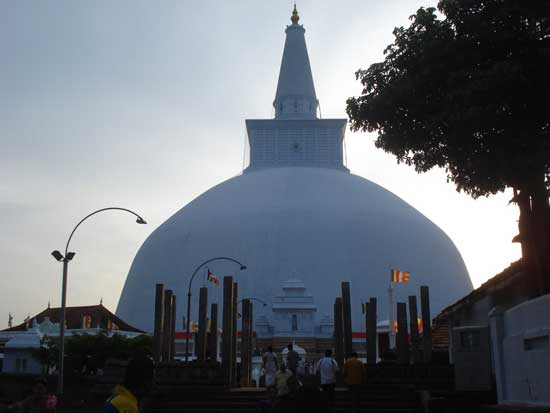Unravelling the mysteries of the Mahathupa
For architect Shereen Amendra, the fascination of the Mahathupa (the original Pali name which she prefers) began when she was a teenager. Her mother Doreen Alles’s copy of the Mahavamsa much-thumbed had no less than four chapters dedicated to the stupa.

The Ruwanweli-seya: The Mahathupa of Anuradhapura
Being her parents’ child, her father A. C. Alles, the renowned judge and connoisseur of Lanka’s shrines, ruins and wilds, and mother Doreen who accompanied him to faraway haunts and herself a writer, Shereen needed no special bidding. She recalls standing by her father near the Samadhi statue when he told her “this is your heritage.”
Shereen, today an elegant 75-year old, has now come out with a reprint of her 2006 book, Beyond the Seeing Eye: The Mahathupa of Lanka, a volume that is the efflorescence of years, nay decades, of work.
The spiritual significance of the Mahathupa is not lost on Shereen for all that she dwells on its advanced architecture and technology in the book (and for all that she had her schooling at St. Bridget’s Convent): the stupa, she reminds us, first of all was ordained in the Buddha’s time though it was built by King Dutugemunu, and has a drona (i.e. 12.288 kilos) of the Buddha’s sacred relics enshrined within.
In other words, no stupa or indeed building in Lanka’s shores has been ever vested with such importance.
But it is also as a scientist that she looks at the stupa’s ‘mind-boggling’ structure- as someone fascinated by physics (ever since she read, as a girl, the books The Restless Atom by Alfred Romer and Just Six Numbers by Martin Rees).

Archt. Shereen Amendra receiving a Special Award from the Sri Lanka Institute of Architects, and at home with the new edition of her book. Pics by Archt. Migara Alwis and Nilan Maligaspe
What first piqued Shereen’s curiosity was that the dome we see today conceals much that went into the foundation. Why? she wondered, that special elaborate sequence (in that precise order) of layers of “round stones, butter clay, bricks, rough cement, iron, marumba, quartz crystal, stones, phosphorous and borax, copper, arsenic in sesamum oil, then silver”, as detailed in the Mahavamsa?
Working on the clue that some of these elements are connected with the manufacturing of silicone chips, she was stunned to find a “curious parallel” between silicone chip technology and the stupa’s base.
Then, Shereen was reminded of the fact that our ancient stupas, in times with no lightning rods, were never victims of the lightning that could crack asunder the dry zone skies.
It was in a curious source that Shereen found a clue- a tome called Manjusri’s Vaastu Vidyaa Saastra translated from the Sanskrit by M. H. F. Jayasuriya, Leelananda Prematilleke and Roland Silva- from a 5th or 6th Century ola manuscript that gives the basis of ancient Sinhalese architecture.
In the treatise, was given in detail how the pinnacle of the stupas of the day were built- not the spire-pinnacle we know but a chathra or disc-pinnacle. Copper was used as part of this.
After building miniature models of such a stupa, Shereen realized copper was used because it was a conductor. It was capable of drawing down electricity from the huge cumulonimbus clouds (thunderclouds) which then would flow off the copper leaf. The charge will spread over the dome and will be ‘very weak’ when it comes to the ground.
“They knew something,” says Shereen with conviction and, though she admits this is only a premise, as she says it makes the Mahavamsa “far more credible.”
Of central importance was the stupa’s relic chamber, made of six medha-pindika or “fat-coloured stones” brought from the land of the Northern Kurus. These Shereen opines could be sandstone.
At the base of the relic chamber was coral and pearl (insulators) and in the very centre of the stupa, a silver Bodhi tree with “its roots resting on sapphire”. Above it was a net of gold and around it seats for eight Buddha statues- the statue at the east having eyes of sapphire “and made of all sorts of other precious materials”. Curiously this is the first mention of Buddha statues anywhere. There were also devas holding mirrors and sapphires ‘the size of thiyambara fruit’ on an arc of crystal in the four corners.
In that hallowed ceremony when the relics were enshrined in the chamber, the Mahavamsa says Dutugemunu “climbed up, then descended into the relic chamber”. Shereen thinks the superstructure would have been completed halfway, forming a deck for the multitudes who flocked in to pay homage at the occasion.
The Mahavamsa mentions many haaskam or miracles like the box of relics opening itself and taking the form of the Buddha in the sky and Shereen says we cannot entirely discard such stories “‘because there is so much we don’t know”.
As Dutugemunu was to fall ill and die before the Ruwanweliseya was completed his brother Tissa before the death had the half-completed shrine covered with pristine white cloth and says the Mahavamsa had crushed pearls applied on to it for Dutugemunu to see. Shereen says this indicates that the dome was meant to glow after completion which gives credence to her premise: the pinnacle and the electron plasma would have made the dome glow with free protons.
All this is just the tip of the iceberg; the book is packed with other intricate details of what Shereen calls the inspired “Grand Design” of the Mahathupa. Her writing is imbued with a deep love for science, and her polymath mind and wide learning and reading (as befits the President of the Royal Asiatic Society which she currently is) is very much in evidence. Very erudite but easy in style, elegant, rich, the text is to be savoured.
Recently given a special prestigious award by the Sri Lanka Institute of Architects for her work, Shereen has also been President of the Sri Lanka Institute of Landscape Architects and President of Section C of the Sri Lanka Association for the Advancement of Science. Amongst her many commitments she still lectures and is also a consultant at the Moratuwa University.
Beyond the Seeing Eye: The Mahathupa of Lanka is priced at Rs. 4000 and available at leading bookshops.
Searching for an ideal partner? Find your soul mate on Hitad.lk, Sri Lanka's favourite marriage proposals page. With Hitad.lk matrimonial advertisements you have access to thousands of ads from potential suitors who are looking for someone just like you.


